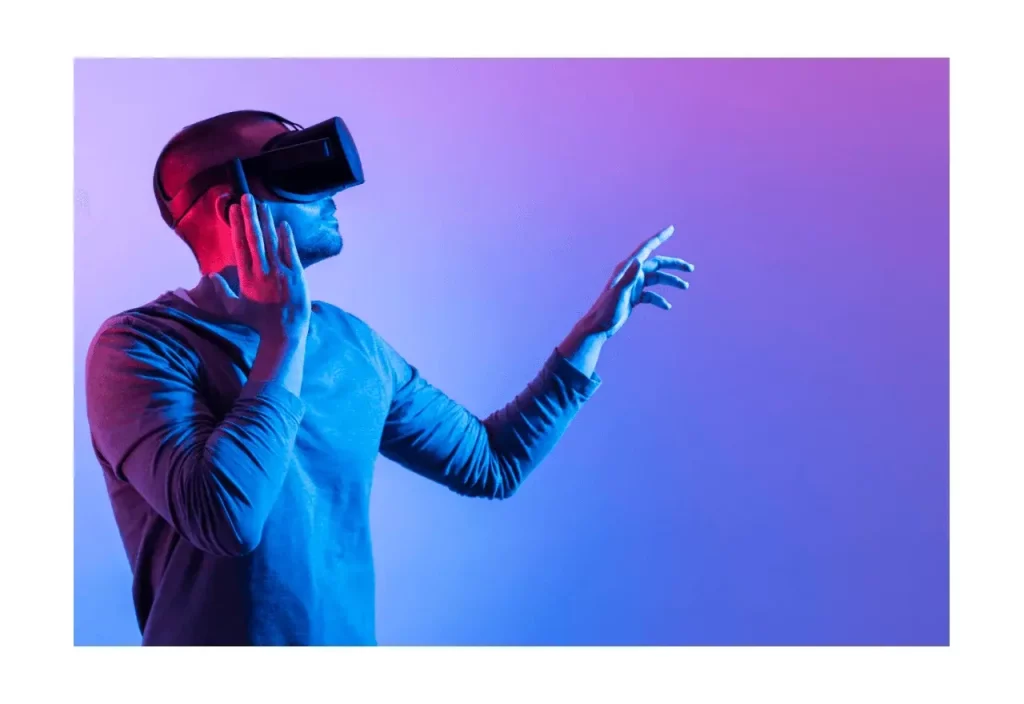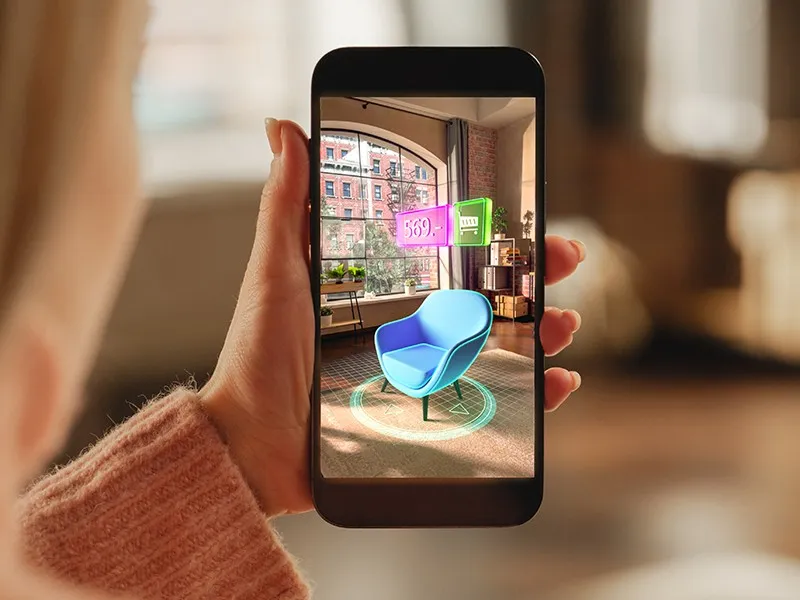Virtual Reality and Augmented Reality
Virtual and augmented reality (VR/AR) are not just technologies. They are portals to new worlds where the boundaries of reality dissolve and the possibilities become endless. Every day, these innovative technologies are penetrating deeper into our lives, transforming the way we interact, entertain, learn and create.
Virtual reality transports us to parallel universes where we can explore unimaginable landscapes, interact with objects, create and participate in exciting adventures without leaving the comfort of our cozy room. Augmented reality expands our perception of the world around us by adding digital layers of information and interaction to real-world objects.
From medicine to education, entertainment to industry, VR/AR is infiltrating all areas of our lives, redefining the way we communicate, create, and teach. In an era where imagination is becoming more important than ever, VR/AR opens the door to endless possibilities for creativity and innovation. In this article, we’ll talk VR/AR, exploring their possibilities.
VR

Virtual Reality (VR) is an exciting world of possibilities where reality intertwines with the virtual. It allows us to immerse ourselves in unique and amazing virtual environments where we can explore fantasy worlds, communicate with others, and interact with objects that might remain inaccessible in real life. With the advancement of virtual reality technology, there are more and more opportunities for learning, entertainment, medicine, engineering and other fields. From enhanced graphics and sound effects to intuitive controls and a sense of presence, VR continues to change the way we think about what is possible in the virtual world.
AR

Augmented Reality (AR) offers us a unique opportunity to intertwine the real world with virtual elements, creating amazing new interaction scenarios. With AR, we can see additional information about the world around us, expand our ability to interact with objects and subjects, and bring new dimensions to our daily lives. From gaming and entertainment to business and education, AR is infiltrating all areas of our lives, opening up new ways for us to perceive and interact with the world. As technology advances and the number of AR-enabled devices increases, we can expect even more exciting and innovative applications of this amazing technology in the future.
The difference between VR and AR
VR allows you to fully immerse yourself in a virtual world, creating the illusion of real presence.
AR, on the other hand, superimposes virtual elements on the real world, expanding its possibilities.
Together, VR and AR create a new reality that borders on the fantastic.
| Characterization | VR | AR |
| Determination | Total immersion in virtual space | Overlaying virtual objects on the real world |
| Surroundings | Immersive, virtual space | Real environment with virtual additions |
| Interaction with the world | Virtual interaction with objects | Interaction with real and virtual objects |
| Examples of applications | Games, education, training, entertainment | Marketing, training, customer service, medicine |
| Examples of devices | Oculus Rift, HTC Vive, PlayStation VR | Google Glass, Microsoft HoloLens, Snapchat фильтры |
| Equipment requirements | High performance, availability of VR helmet | Camera and display on the mobile device, AR-glasses |
| Limitations | May cause disorientation, requires space. | Dependence on camera and display quality, limitations of technical implementation |
| Future | Improvements in graphics, sensors, ergonomics | Integration with IoT, AI, functionality expansion |
How AR/VR is changing the world?
Augmented (AR) and virtual (VR) reality are rapidly evolving and are already impacting many areas of life.
Examples:
1. Education:
AR/VR technologies enable the creation of interactive educational materials that make learning more engaging and effective.
Students can virtually travel to historical sites, explore the internal structure of the human body, or conduct experiments in a safe virtual environment.
AR/VR is also used to teach employees new skills and enhance their skills.
2. Medicine:
AR/VR technologies are revolutionizing the field of medicine.
VR is being used to treat phobias and post-traumatic stress disorder (PTSD), while AR is being used to perform surgical procedures with greater precision.
AR/VR is also helping doctors make diagnoses and develop treatment plans.
3. Entertainment:
AR/VR games are becoming increasingly popular.
They allow players to immerse themselves in virtual worlds and experience new sensations.
AR/VR is also being used to watch movies and concerts.
4. Social interaction:
AR/VR technologies open up new opportunities for social interaction.
People can communicate with each other in virtual worlds regardless of their location.
AR/VR is also used to create virtual communities where people can share their interests and socialize.
Apart from these examples, AR/VR technologies are also used in many other fields such as tourism, sports, design and architecture.
The impact of AR/VR on the world will only increase in the coming years.
These technologies have a huge potential to change our lives for the better.
What opportunities does AR/VR offer for businesses?
AR/VR offers businesses a wide range of opportunities that can improve processes, increase efficiency, and engage customers. Here are a few key aspects:
- Learning and training: VR/AR provides immersive learning and training opportunities. Employees can immerse themselves in virtual environments to learn new skills, workplace safety, or solve complex problems.
- Marketing and Sales: With AR, businesses can give customers the ability to “try on” products or interact with them in a virtual environment before purchasing. VR also allows businesses to create unique virtual stores or spaces to sell products and services.
- Product Design and Development: Virtual prototypes and simulations allow companies to test and improve their products before they are physically created, reducing research and development costs.
- Manufacturing and logistics management: VR can be used to optimize manufacturing and logistics processes by allowing employees to interact with data and manage systems remotely or in a virtual environment.
- Customer service: AR can be used to create interactive product service and repair manuals, helping customers resolve issues faster and easier.
- Virtual Events and Conferences: Virtual platforms allow businesses to host events, conferences and meetings without the need to be physically present, reducing travel costs and ensuring accessibility to attendees from different time zones.
These are just a few examples of how AR/VR is transforming business processes and opening up new opportunities for companies to grow in the digital age.
The Future of VR and AR
The future of virtual and augmented reality (VR/AR) promises to be exciting and transformative for many aspects of our lives. As technology advances and the availability of devices capable of delivering immersive experiences improves, we can expect a number of innovations and changes:
- Improved user interfaces: In the future, VR/AR will become more accessible and intuitive by developing new interfaces that make it easy to interact with virtual and augmented worlds.
- Integration with other technologies: VR/AR will become increasingly integrated with artificial intelligence, the internet of things and blockchain, leading to new capabilities and applications in various fields.
- Medicine and healthcare: VR/AR will play an increasingly important role in medicine and healthcare, providing new ways to diagnose, treat and rehabilitate, and train medical staff.
- Education and Learning: Virtual and augmented reality will become an integral part of the educational process, allowing students to immerse themselves in unique learning environments and experiment with new concepts and ideas.
- Entertainment and Culture: VR/AR will continue to transform the entertainment and culture industry by offering more engaging and interactive forms of entertainment, including movies, games, concerts and museums.
Conclusion
Virtual and augmented reality are already changing our world today, and their potential is only beginning to be realized. From personal entertainment to industrial innovation, VR/AR is infiltrating every aspect of life, opening up new opportunities for learning, entertainment, medicine, business, and more. With each passing day, these technologies are becoming more accessible and intuitive, allowing us to tap into new dimensions of reality. The future of VR/AR promises to be exciting and inspiring, full of innovations and opportunities that will help us create a more progressive and advanced society.
.png)